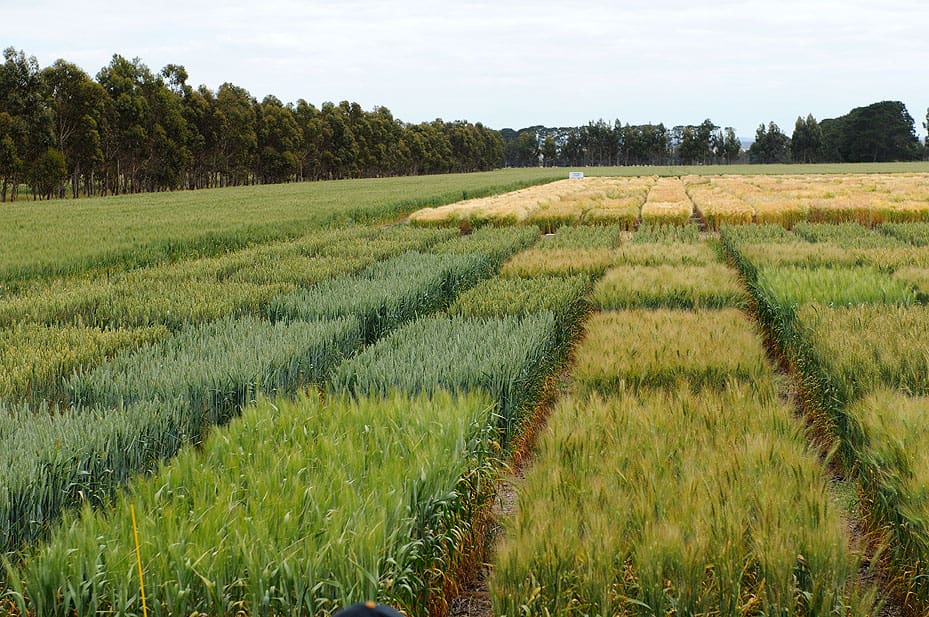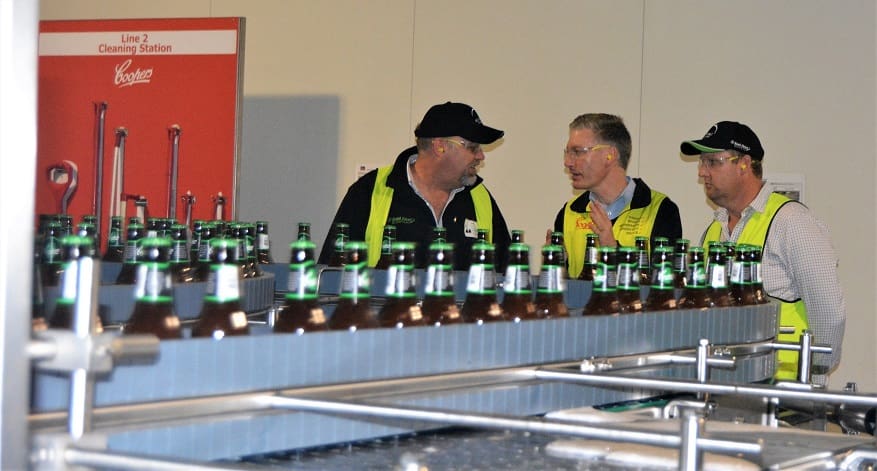
Barley breeders and variety evaluators have long-term programs involving trial sites like this one near Geelong which are unlikely to be affected by China’s tariffs on Australian barley. Photo: GrainSearch
BARLEY is a robust and valued inclusion in most winter-cropping rotations in Australia and, China or no China, domestic and export markets and on-farm use will absorb it in coming seasons.
That’s the verdict from some in the grain industry one week on from China’s imposition of an 80 per cent tariff on Australian barley for up to five years.
Barley breeders and evaluators are also expected to plough on with their programs in the quest for improved varieties, while exporters look to emerging and expanding malting-barley markets like India, Thailand and Vietnam.

Brett Hosking
Food and feed barley buyers like Japan and the Middle East are likely to provide support now that Australia’s forward drought-feed demand has largely evaporated. The prospect of increased local processing of barley for malt production is also thought to be gaining traction.
With regard to the tariff, GrainGrowers chairman Brett Hosking said an industry phone hook-up yesterday with Minister for Trade Simon Birmingham pointed to direct negotiations with China as being a sensible step for Australia to take.
This may be followed by an appeal to the World Trade Organization (WTO).
“The first response before we do anything is to pursue diplomatic negotiations, and the next step to look at is a domestic appeal within China’s legal system, and maybe the WTO after that,” Mr Hosking said.
“We have 60 days from 18 May to lodge an appeal within China’s judicial system, and they have 90 days to respond.”
Mr Hosking said GrainGrowers, Grain Producers Australia, Grain Industry Market Access Forum, Grain Trade Australia and major Australian grain exporters were jointly considering lodging an appeal within China.
Breeding a long game
Seed companies fund their programs that develop and evaluate new barley varieties through levying growers under plant breeders’ rights (PBR) legislation.
Any drop in Australian malting barley area will impact the income of seed companies, and those which responded to Grain Central about the possible impact of China’s move said they expected it to be minimal when it comes to the search for new varieties.
GrainSearch holds the PBR in Australia for Westminster, a variety bred in the United Kingdom which is one of Barley Australia’s (BA) nine preferred malting varieties.
“It takes approximately seven years for a new barley variety to reach the marketplace for growers to plant and for the industry to utilise,” GrainSearch business manager Philip Jobling said.
“Therefore, whilst the China barley tariffs will likely impact our short-term budgeting if there is less barley sown, we hope it will not affect our long-term focus on finding new varieties.
“We will continue to search for all types of suitable barley to bring to market – from domestic malting, export malting and even feed-quality varieties.”
Seed Force collects end-point royalties on RGT Planet, an EU-bred global variety which now accounts for up to 30pc of Australia’s barley area.
In high-yielding regions like Victoria’s Wimmera, it has produced up to 7 tonnes/hectare dryland in trials and as a commercial crop, and is a preferred BA malting variety.
Seed Force technical manager David Leah said the company also shared the long-term view with regard to China.
“It won’t have any effect on our breeding programs; it’s a long-term operation,” Mr Leah said.
“Barley is the lowest-risk crop of them all and the cheapest to grow, and I don’t think farmers will drop it out of their rotations altogether because of what’s happened with China.”
RGT Planet is already in use in China and other markets, and is available from origins other than Australia.
However, the vitality of Australian-origin barley in the malting process is outstanding.
Opening for malt
Grain Central understands some Australian malthouses are operating below capacity, and are looking at ramping up production to export more malt to markets including China.
Victorian Farmers’ Federation grains manager Simon McNair said increased domestic malt production would support malting-barley values.
“There is an opportunity for Australian maltsters here, and we have a freight advantage over European maltsters,” Mr McNair said.
“The malting premium in Australia will be eroded a little bit further, but if every maltster finds some extra capacity, that could change.”
Grain Central understands China does not have a tariff on Australian malt.
New South Wales and Queensland each only have one industrially operated malthouse, Axéréal at Minto south of Sydney, and United Malt Group’s Pinkenba facility in Brisbane.
Therefore, increased malting capacity is expected to come from South Australia, Victoria, Western Australia and possibly Tasmania.
Invitation from SA
Grain Producers SA (GPSA) chair Wade Dabinett said SA had a “very good malt industry”.
As the home to Coopers Brewery, Axéréal’s Port Adelaide malthouse, and barley breeding and evaluation programs which interface with organisations including global brewing giant Carlsberg, few could argue.
“SA grows great-quality malting barley very consistently, and our major malting and brewing centres are relatively close to the growing areas,” Mr Dabinett said.
“If anyone would be looking to build malting capacity in Australia, it should be in SA.”

Seed Force’s Tim Wilmshurst with Coopers Brewery maltings manager, Doug Stewart, and Seed Force technical and extension agronomist, David Leah, at the bottling line.
Price impact
Australia’s barley price fell prior to the tariff announcement when news that it was being proposed reached the market.
Sources in the trade have told Grain Central that values rebounded slightly once the tariffs were imposed, and prices have now stabilised.
“Price recovery for feed barley should stay in the $220-$250/tonne export zone price once the initial dust has settled, but it will be dependent on the Australian dollar not moving higher and also on making its way back lower,” Rabobank’s senior grains analyst, Cheryl Kalisch Gordon, said.
“I’d expect that we should see less of a drop so that the malt-feed spread opens towards long-term averages, after being narrow to non-existent during much of the past two to three years due to drought,” Dr Kalisch Gordon said.
Mr McNair said malting barley’s premium over feed had historically been around $50/t.
“Now it’s more like $20/t, and some say it’s gotten down to $10/t,” Mr McNair said.
The eroded premium reflects the rise in Australian feed barley prices over world values, which domestic users in eastern states had to pay to keep SA, Victorian and WA barley away from export.
Yield buffer
Increased yields in barley varieties now available have reduced grower susceptibility to the drop in malting’s premium over feed.
Now that nearly all of SA’s winter crops for the current crop year have been sown, Mr Dabinett said this could factor into following seasons without China in the market.
“It’s also possible that some growers may look to volume feed-grade barley instead of trying to produce malt.”
Grain Central: Get our free daily cropping news straight to your inbox – Click here

HAVE YOUR SAY